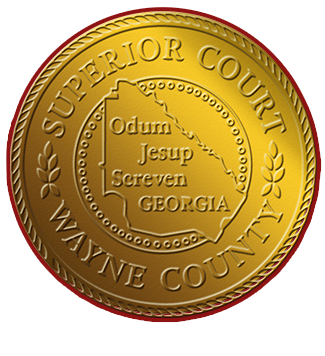BRUNSWICK MODEL
Overview
Unique among all drug courts and is used for the model of other courts in Georgia for funding purposes.
1. Screening and Eligibility:
The responsibility for screening offenders for legal eligibility is placed on the District Attorney’s Office. Referrals may be made by the public defender or private attorneys to the District Attorney. The Sheriff of each county will notify the Judge of that county of the arrests of drug offenders within 24 hours. The judge presiding over the Drug Court shall review the list for persons accused of drug violations. Those persons shall not be allowed to bond out of jail except through a bond issued by the Judge presiding over the Drug Court. Within seven days the District Attorney will determine which of these arrestees are candidates for Drug Court treatment. Those candidates will be screened by the treatment providers within the next seven days. If the participant is eligible according to the treatment staff then the defendant must make a decision with the advise of counsel as to whether the defendant wants to enter the drug court treatment program. If the defendant elects not to enter the drug treatment program the presiding Judge sets bond. If the defendant elects to enter the program the defendant enters a plea of guilty, signs a contract and other relevant documents and receives an own recognizance bond. Adjudication is withheld at this time. Treatment begins the day the defendant decides to enter the drug court treatment program. Persons not entitled to drug treatment are immediately bonded by the judge presiding over the drug court. This judge also presides over all drug cases whether in drug program treatment or not.
In summary, cases are presented as follows:
A.) Cases come into the drug court by means of post-arrest screening by the District Attorney with referral by Defense Attorney.
B.) If an offender who is a first offender successfully completes the drug court program, the criminal prosecution against them is resolved by allowing the defendant to withdraw his or her plea and the case is dismissed.
C.) If an offender does not complete the drug court program the criminal prosecution against them is resolved by removing the case from the special procedures applicable to cases referred to the program and returning it to normal criminal case procedures which would include 20 to 24 months in a detention center. If the defendant has a prior conviction for a nonviolent drug offense but has had no chance at treatment, that defendant may be allowed in treatment. In that case, the defendant is given a prison term which is suspended so long as the defendant successfully completes drug treatment.
2. Clinical Screening:
A.) The clinical screening process is completed by qualified personnel who screen for substance use/abuse, mental health issues, motivation for treatment, residential needs, and level of care. The ASI and the SASSI are the major screening/assessment instruments used.
B.) The time period for initial screening is seven days after arrest. After the screening, if the defendant qualifies and agrees to enter the drug court program, a contract is entered into between the defendant and the court. The contract will specify the terms of the treatment program, incentives, and sanctions. The contract orders that the defendant pay a minimum fee of $1,000.00 into the drug court program over the course of the two year treatment period. These funds will be used to assure future funding of the Drug Court when grant funds have been exhausted.
3. Clinical Assessments:
A.) Assessments are the responsibility of the treatment coordinator/program manager and the treatment team. Assessments will begin on the day the client arrives in treatment and may continue for six weeks before a final level of care is assigned. For those clients who need detoxification, appropriate referrals will be made. Ambulatory detox clients and others are assigned to an evaluation group. Residential needs are addressed immediately and placements made when appropriate.
Assessment criteria includes: substance abuse history, medical/health assessments, criminal history, mental health assessment (including potential for suicide), family history, relationship and support system, education and employment assessments, history of treatment.
Level of care is assigned – Four levels of care can be provided by the drug court treatment team: ASAM Level 1, 2.1, 3.1, and Level 4. Medically needed detoxification will be provided by the locally state run facility or by a private hospital.
4. Treatment Continuum and Plan:
A.) The treatment plan is developed by certified addiction counselors, licensed clinical social workers, registered nurses with medical and legal consultation.
B.) The treatment plan is updated periodically, reviewed, and approved by the Judge.
C.) The substance abuse treatment services available to participants are as follows: Addiction group counseling, in conjunction with self-help groups (AA, NA), addiction education, related group sessions and individual counseling which includes: (1.) An individualized program plan which is updated as patient needs change (2.) Case management (3.) Referral to specialty programs and (4.) Group and individual programs related to “living” problems, which emphasize relationships and family issues and anger management. Education and vocational training will be provided as necessary.
D.) Drug Testing. Participants are required to wear dry patches provided by Pharm Chem. These patches test for marijuana, opiates, cocaine, amphetamines, and PCP. Random urine screens are used for Benzodiazepines. If a screen is positive, sanctions will be imposed within 48 hours. All drug testing follows a strict chain of custody and is performed by trained professionals hired by the Court.
E.) The ancillary health services available to participants include screens for Hepatitis B and C, HIV, and TB. Hospital inpatient detoxification is available. Acupuncture will also be available as a treatment option.
5. Sanctions and Incentives:
Sanctions include admonition from the judge, increased frequency of court status hearings, increased frequency of drug testing, community service, increased treatment intensity, monitoring, progressively longer incarceration stays, curfews, in-court sentencing, and termination from program and sentencing to include incarceration.
Generally, sanctions are applied as follows:
1.) Intermediate sanctions will be used to address non-compliance with the treatment program and/or a positive screen. The ultimate sanction of expulsion and resumption of prosecution of the criminal charge in the normal manner will be reserved for instances of new criminal behavior (other than drug use detected by program screening) and failure to conform to the obligations imposed by the program after less severe sanctions have been imposed.
2.) Mandatory expulsion will result from new felony offenses or violent misdemeanor offenses or driving wile under the influence (DUI).
3.) Expulsion will be considered by the court upon recommendation of the treatment team after three positive drug screens and after repeated failure to attend mandated treatment programs or court appearances.
Incentives include passing to another phase of the program which requires less frequent random testing and less time in mandatory treatment, praise from the judge, peer praise, placement on a peer counseling team, and graduation from program and dismissal of charges.
6. Graduation:
In order to graduate from the drug court program the participant must have successfully completed the twenty four month treatment program, had one consecutive year of negative drug screens, no additional violations of the law, enhancement of educational and/or vocational skills, and regular attendance at counseling, self-help programs, court status meetings, payment of all fees, and provided services to charity of their choice.








